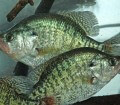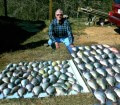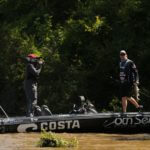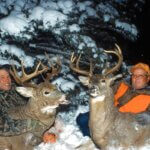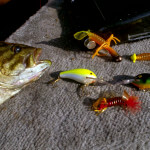John’s Note: From February through the end of April, water levels on both the Warrior and the Tombigbee rivers where David Spain fishes in central Alabama, often will change drastically, because of spring rains that begin in February and don’t occur quite as frequently in May. So, we wanted to know how Spain fished in different water levels.
 I’d much rather fish for crappie when the water is rising. The crappie seem to feed better and feed more aggressively as the water comes up. As the water rises, it inundates new ground, which provides more food for the bait fish and more bait for the crappie. We also know that when we have spring floods, the crappie tend to get off a better spawn than they do when our rivers don’t flood. When the river is falling, I think the crappie begin to wonder, “If I bed now, where will my bed be when the water goes down?” The fish tend to spook more and are less reluctant to eat when the water is falling than when it’s stable or rising.
I’d much rather fish for crappie when the water is rising. The crappie seem to feed better and feed more aggressively as the water comes up. As the water rises, it inundates new ground, which provides more food for the bait fish and more bait for the crappie. We also know that when we have spring floods, the crappie tend to get off a better spawn than they do when our rivers don’t flood. When the river is falling, I think the crappie begin to wonder, “If I bed now, where will my bed be when the water goes down?” The fish tend to spook more and are less reluctant to eat when the water is falling than when it’s stable or rising.
Today, March 8, 2016, the water is falling. We had major flooding conditions upstream the week before, so the river was really high. But now that the water is starting to fall, we don’t tend to catch as many crappie as we do when it’s rising. When we have flood stages, one thing I’ve noticed is the dams usually run water (drop the river levels) in the mornings, and the water generally stabilizes in the afternoons. For that reason, we’ll often catch more crappie in the afternoons when the river levels aren’t being lowered than we do in the mornings.
Another advantage that we have by basing our fishing at Demopolis, Alabama, is we can fish both the Warrior and Tombigbee rivers from this launch site. Rarely, if ever, will water levels be the same on both rivers. Since most of our rains come from the west in Alabama, the Tombigbee River will usually come up faster than the Warrior River and will hold that high water level much longer than the Warrior River. So, depending on river levels, and which river is falling the most and the fastest, we can fish the other river. When we fish just one river, we don’t have an option if the river is stained or falling a lot. But by having two rivers we can fish, most of the time, one river will produce more and bigger crappie than the other throughout the spring. So, if we’re not catching the size and number of crappie that we want to catch from the Warrior River, we can start fishing the Tombigbee River and often increase the size and number of crappie that we’re catching.
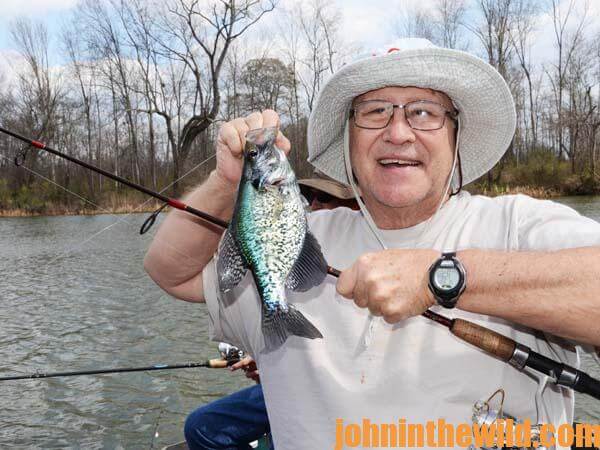 I really prefer fishing in the early mornings or the late afternoons. Usually, we eat lunch in the middle of the day, because most of the time, this is when the crappie are least likely to bite. I like to get to the lake just when we have enough light to see how to put the boat in the water. Often by being the first one on the water, we catch our most and biggest fish. I also prefer to fish on the week days. Most crappie fishermen have to fish on the weekends, and I’m not the only person who knows where the crappie hold and how to catch them. We can get an awful lot of boat traffic on some of the places I fish on the weekends. I’ve also learned that if we really don’t pound the same banks all day long, the areas where we’ve caught crappie in the mornings will replenish themselves with crappie overnight. Then we can return to those same banks and fish the same way we’ve fished the morning before. Often, we can catch just as many, if not more, crappie than the first day we fished that bank. In the afternoons, the crappie tend to move closer to the surface of the water than in the mornings, which is easily explained. If the sun has been shining, the top story of water will heat up quicker than the deeper water.
I really prefer fishing in the early mornings or the late afternoons. Usually, we eat lunch in the middle of the day, because most of the time, this is when the crappie are least likely to bite. I like to get to the lake just when we have enough light to see how to put the boat in the water. Often by being the first one on the water, we catch our most and biggest fish. I also prefer to fish on the week days. Most crappie fishermen have to fish on the weekends, and I’m not the only person who knows where the crappie hold and how to catch them. We can get an awful lot of boat traffic on some of the places I fish on the weekends. I’ve also learned that if we really don’t pound the same banks all day long, the areas where we’ve caught crappie in the mornings will replenish themselves with crappie overnight. Then we can return to those same banks and fish the same way we’ve fished the morning before. Often, we can catch just as many, if not more, crappie than the first day we fished that bank. In the afternoons, the crappie tend to move closer to the surface of the water than in the mornings, which is easily explained. If the sun has been shining, the top story of water will heat up quicker than the deeper water.
 Although I fish the jig and cork about 90 percent of the time, often when the bite slows down, I’ll use a 1/16-ounce jighead with a curly tail grub on the back of the jig. To see if the crappie have moved, or if they prefer jigs that look different than the jigs we’ve been fishing, I’ll also switch the type jig I’m using from a tube jig to a Kalin jig to learn if the design of the jig can get me more strikes. When the crappie slow down biting on the tube jig, I’ll start tight-line fishing (no cork) with the Kalin grub, because it has a faster tail action than the tube jig. That faster tail action will get me more strikes, and I’ll catch more crappie than I was catching with the tube jig.
Although I fish the jig and cork about 90 percent of the time, often when the bite slows down, I’ll use a 1/16-ounce jighead with a curly tail grub on the back of the jig. To see if the crappie have moved, or if they prefer jigs that look different than the jigs we’ve been fishing, I’ll also switch the type jig I’m using from a tube jig to a Kalin jig to learn if the design of the jig can get me more strikes. When the crappie slow down biting on the tube jig, I’ll start tight-line fishing (no cork) with the Kalin grub, because it has a faster tail action than the tube jig. That faster tail action will get me more strikes, and I’ll catch more crappie than I was catching with the tube jig.
To learn much more about crappie fishing, get John E. Phillips’ Kindle eBooks and some print books, “Crappie: How to Catch Them Fall & Winter,” “Crappie: How to Catch Them Spring and Summer,” “Catch Cold Water Crappie Now” and “Catch Crappie All Year: Fishing a Single Pole, Using No Boat and Farming Crappie.” Click here to get these books.
To receive and download for free “The Crappie Catchers’ Cookbook,” by John and Denise Phillips that offers free recipes, go to https://johninthewild.com/free-books.

